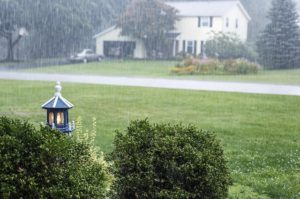
If your lawn has recently had to endure heavy rainfall, you may not be sure what care your lawn needs.
If your lawn has recently had to endure heavy rainfall, you may not be sure what care your lawn needs. After every extreme weather event – drought, heavy snowfall, bitter cold, and heavy rain – you must consider what specific care your lawn may need to bounce back and maintain its health. If your yard is soaked after a summer rain, remember these tips for applying lawn care after heavy rainfall.
Wait to Mow Your Lawn
Do not mow your lawn shortly after heavy rainfall. Wait until your lawn dries completely before cutting it because mowing wet or damp grass can cause issues such as compaction, ruts in your soil, and possibly damage to your electric mower battery if you use one. The grass clippings will also be very clumpy which can lead to more cleanup issues as well as possible fungal issues if the clumps are not cleaned up.
Stay Off the Lawn
Walking on your lawn after heavy rainfall can also cause some serious damage. When your lawn is wet, your grass loses the natural spring that allows it to remain more resilient during drier periods when traffic is more frequent. Walking across wet grass can also lead to soil compaction, which prevents your grass from receiving the oxygen and nutrients it needs. Root damage is also possible due to the softness of the soil surface.
Aerate Your Lawn
If your lawn is already compacted, you should consider scheduling an aeration at the appropriate time of the year. Typically, spring and fall are the best time to perform aeration services. Aeration creates small holes in your soil that improve drainage and increase grass growth while promoting turf recovery. Aeration may give your grass the help it needs to bounce back better and faster than before.
Track Flooded Areas
Preventing your lawn from initial flooding is very difficult. However, after the rain has fallen and some areas may have flooded, note the different areas that are flooded so you can plan to even out these sections later. By leveling out the ground or perhaps even considering subsurface drainage systems, you can vastly improve the drainage of your lawn in preparation for future heavy rainfalls.
Watch for Weeds
While rain can spur new grass growth, it can also energize the growth of pesky weeds. If you notice weeds competing with your recovering lawn for sun and nutrients, remove them as soon as possible by the root or scheduling an additional application to control weeds.
Scientific Plant Service Is Your Go-To Source In Landscape Healthcare
Scientific Plant Service, located in Baltimore, is a privately owned corporation, chartered in Maryland in 1957 by Frank J. Burke. We started as a full-service Arborists specializing in the care of shade trees and ornamental shrubs, but today we are a Lawn Care company that is a huge part of the community. From aquatic environments and snow management to deer and mole control, SPS has services tailored specifically for your lawn and landscape.
We offer services in Maryland, Washington, DC, and Virginia, including: Harford, Baltimore, Carroll, Frederick, Howard, Anne Arundel, Montgomery, Prince Georges, Talbot, Queen Anne’s, Calvert counties in MD, as well as Loudoun County, Fairfax County, Arlington, Alexandria, and Falls Church in VA. For more information, contact us online, or call us at 410-321-0970. Be sure to follow us on Facebook, Twitter, LinkedIn, Instagram, and Pinterest.

